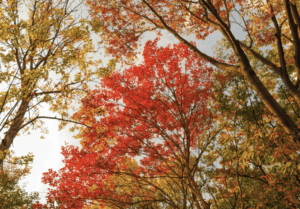Notable Natives: Black Gum - A Tree for All Seasons, but Especially the Fall
By Su Fiske, Inland Bays Garden Center | Special to the Coastal Point | Oct 27, 2022

Coastal Point • Stock photo
Fall is a perfect time to plant, especially one of my favorites — the black gum!
This season, with its warm soil temperature, allows flora to focus on growing their roots, so they are better able to sustain their health during hot temperatures and drought in the upcoming year. Plants spend less energy on their flowers or foliage during these shorter, cooler days. They also need less watering this time of year because they are losing less water through their foliage.
Additionally, common garden pests and disease problems are less of a problem. Plus, trees and shrubs offer beautiful fall color, such as is found in the black gum (Tupelo, which means swamp tree in Muscogee) nyssa sylvatica. This tree was named in honor of the mythological Greek water nymph, Nyssa.
The black gum are also called gum tree, yellow gum, bowl gum, pepperidge, tupelo gum or sour gum. The tree is native to Delaware and is commonly found in our woodland areas. Their gray bark is remarkably interesting because of it being divided into rectangle by black crevices (I love a good bark).
The black gum fruit is bluish black (drupe) and is loved the birds, and new sprouts are eaten by deer. Due to the fruit’s high fat and fiber content, the tree’s fruit is an important food source for wildlife. The fruit starts to ripen in September.
Their autumn color is stunning shades of yellow, orange, bright red and purple, and it is the first tree to show off in the fall. Summer leaves are a dark green with a glossy appearance, and the flowers are small greenish-white. Bloom time is April through June.
Growing 30 to 50 feet tall, with a spread of 20 to 30 feet the black gum is a great focal plant. The growth rate is considered medium, 12 to 24 inches per year. The Tupelo can take full sun or partial shade (at least 4 hours of sun). They prefer well-drained, acid soils with a loamy, sandy texture, and can tolerate drought, as well as withstand ice, wind and salt spray. Tupelo is low-maintenance plant that is not affected by cold or warm weather or humidity. Black gums have a long tap root that travels deep into the ground, so after the first year they do not require regular watering.
Fun facts: the black gum are loved by honeybees. I am sure you have heard of Tupelo honey! Also, way back in the day, the solid wood of the black gum was used for water pipes, and they are one of the longest-lived hardwood species in the Eastern U.S.
Read the article in the Coastal Point here.

